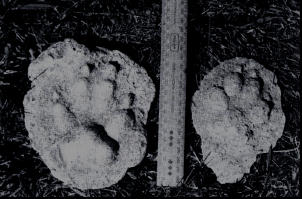Australian Panther | Australian Panther | Australian Panther
Research of the
Australian Panther
Australian Panther | Australian Panther | Australian Panther
Australian Panther Research

Thylacine Plaster Casts
Photo © Rex Gilroy 2006
The Thylacine / Tasmanian Tiger - Tasmanian Sightings
Prior to the flooding of the Bass Strait land-bridge toward the close of the last great ice age about 12,000 years ago, no natural barrier existed to prevent these animals from entering Tasmania, and it is evident that today, isolated from their mainland counterparts, some of these marsupial carnivores continue to survive there. This is where we begin our study of the Australian Panther.
Snowy Range 1972
Tom (last name witheld), a camper, was with two mates exploring the Snowy Range west of Hobart one weekend in January 1972. On this particular Sunday morning they all spotted a large, black-furred catlike animal observing them from the edge of dense scrub nearby their camp. They had no sooner got to their feet than the creature turned to vanish quickly into the trees. The men later found large paw-prints embedded in soil near their camp, suggesting the animal had been there the previous night.
Later that afternoon Tom went to get water from a creek. As he crouched on the creek's edge beneath a tall boulder, he saw a dark shadow reflected in the water. Before he could turn to look up, he was thrown aside as the dark shape leapt upon him with a screech, then bounded across the creek into bushland. A shocked, badly scratched Tom staggered back to camp. Soon afterward his startled friends went in search of the mystery animal but it had left the area.
Lake Gordon 1989
In April 1989 a group of a dozen people saw a black-furred panther-like animal, about two metres in length from head to tail and standing up to 0.6 of a metre on all fours, as it moved along the shore of Lake Gordon in the Mt Wright area, north of the Snowy Range.
Marlborough Highway 1990
An animal of this size and description was claimed seen bounding across the Marlborough Highway one afternoon in February 1990.
Three Panthers 1980's
Ten years earlier, one eyewitness claimed to have seen no less than three of these large 'panthers' roaming together near Split Rock, west of Great Lake.
Mount Arthur District 1960
This report resulted in one farmer from the Mount Arthur district east of Launceston relating how, one day in 1960, he had watched powerlessly as a "black catlike monster", a good seven feet (2.3 metres) from head to tail, bounded out of scrub onto his property to attack and carry off a large calf.
Pouched Cub 1961
Craig (last name witheld), a young fossicker, was digging in a creek in Ben Lomond National Park one day in 1961 when he realised he was being watched by a large black 'panther' further up the creek on the opposite bank. The animal emerged, then dashed across the shallow creek. It was apparently a female.
"I am positive I saw that it was carrying a pouched cub," he said later to a ranger.
Smithton 1968
A Mr Gregory (last name witheld), his wife and another couple were driving near Smithton in the north-west of the state one March day in 1968 when they drove past a five-foot-long (1.6 m) black-furred "giant cat standing on the scrubby roadside. “We stopped. I backed up the car hoping we could get a better look, but the strange beast had vanished,” he said.
Cradle Mountain-Lake St Clair Region
The Cradle Mountain-Lake St Clair region has long been the scene of ‘panther’ sightings stretching back to last century. In 1970, the region was alive with sightings reports of animals that left paw-prints up to five inches (12.6 cm) in width.
At Mount Olympus, for example, campers discovered massive tracks embedded in mud near their camp, and, at the southern end of the lake, bushwalkers were horrified to discover a dismembered cow, torn apart only a day or two before by a creature whose large paw-prints were still visible in the soil about the site.
This writer frequently receives such tales from widely scattered and remote regions of Australia, and many of these reports concern the often loud, weird, screeching sounds made by these animals.
Great Western Tiers 1928
In 1928, in the Great Western Tiers south-west of Launceston, a group of roadworkers were terrified in their camp one night by the incessant howling and screaming sounds of two or three unseen creatures. The men were convinced the area was inhabited by “Jungle cats” and refused to stay there another night!
Strathgordon 1940
In 1940 outside Strathgordon, west of Lake Gordon in the wild bush country of south-western Tasmania, a farmer and his wife spotted a "seven-foot-length giant panther-like animal as it dashed across their back paddock and leapt effortlessly over a six-foot-tall fence before disappearing into trees.